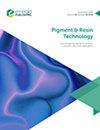力学-化学耦合双网凝胶中橡胶弹性的准周期图模型
IF 1.5
4区 材料科学
Q3 CHEMISTRY, APPLIED
引用次数: 0
摘要
目的研究双网(DN)凝胶的力学化学效应和自生长机理,为橡胶弹性提供准周期模型。设计/方法/方法化学反应动力学用于确定宿主脆性网络的机械化学转变概率,并探索内共生体韧性网络的力学行为。利用2 × 2矩阵的Penrose平铺,提出了宿主-内共生体网络协同耦合的准周期模型。基于橡胶弹性理论和Gent模型,建立了自由能模型,探讨了DN凝胶的本构应力-应变关系。在本研究中,建立了一个准周期图模型来描述脆性网络和韧性网络之间的协同相互作用,它们分别经历力学化学耦合和力学拉伸行为。准周期彭罗斯平铺决定了DNs的力学化学和自生长效应。希望建立两个网络之间主客体相互作用的准周期图模型,探索DN水凝胶在复杂的力学化学作用下的力学和自生长行为的工作原理。通过文献报道的DN凝胶的有限元分析和实验结果验证了所提模型的有效性。本文章由计算机程序翻译,如有差异,请以英文原文为准。
Quasiperiodic graph model of rubber elasticity in double-network gels undergoing mechanochemical coupling
Purpose The purpose of this paper is to study the mechanochemical effect and self-growth mechanism of double-network (DN) gel and to provide a quasiperiodic model for rubber elasticity. Design/methodology/approach The chemical reaction kinetics is used to identify the mechanochemical transition probability of host brittle network and to explore the mechanical behavior of endosymbiont ductile network. A quasiperiodic model is proposed to characterize the cooperative coupling of host–endosymbiont networks using the Penrose tiling of a 2 × 2 matrix. Moreover, a free-energy model is formulated to explore the constitutive stress–strain relationship for the DN gel based on the rubber elasticity theory and Gent model. Findings In this study, a quasiperiodic graph model has been developed to describe the cooperative interaction between brittle and ductile networks, which undergo the mechanochemical coupling and mechanical stretching behaviors, respectively. The quasiperiodic Penrose tiling determines the mechanochemistry and self-growth effect of DNs. Originality/value It is expected to formulate a quasiperiodic graph model of host–guest interaction between two networks to explore the working principle of mechanical and self-growing behavior in DN hydrogels, undergoing complex mechanochemical effect. The effectiveness of the proposed model is verified using both finite element analysis and experimental results of DN gels reported in literature.
求助全文
通过发布文献求助,成功后即可免费获取论文全文。
去求助
来源期刊

Pigment & Resin Technology
工程技术-材料科学:膜
CiteScore
2.80
自引率
21.40%
发文量
91
审稿时长
>12 weeks
期刊介绍:
The journal looks at developments in: ■Adhesives and sealants ■Curing and coatings ■Wood coatings and preservatives ■Environmentally compliant coating systems and pigments ■Inks for food packaging ■Manufacturing machinery - reactors, mills mixing and dispersing equipment, pumps ■Packaging, labeling and storage ■Plus topical features and news on materials, coatings, industry people, conferences, books and so on ■Raw materials such as pigments, solvents, resins and chemicals ■Testing equipment and procedures
 求助内容:
求助内容: 应助结果提醒方式:
应助结果提醒方式:


